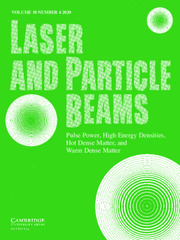Crossref Citations
This article has been cited by the following publications. This list is generated based on data provided by Crossref.
Seidl, P.A.
Baca, D.
Bieniosek, F.M.
Celata, C.M.
Faltens, A.
Prost, L.R.
Sabbi, G.
Waldron, W.L.
Cohen, R.
Friedman, A.
Lund, S.M.
Molvik, A.W.
and
Haber, I.
2003.
The High Current Transport Experiment for heavy-ion inertial fusion.
p.
536.
Prost, L. R.
Seidl, P. A.
Bieniosek, F. M.
Celata, C. M.
Faltens, A.
Baca, D.
Henestroza, E.
Kwan, J. W.
Leitner, M.
Waldron, W. L.
Cohen, R.
Friedman, A.
Grote, D.
Lund, S. M.
Molvik, A. W.
and
Morse, E.
2005.
High current transport experiment for heavy ion inertial fusion.
Physical Review Special Topics - Accelerators and Beams,
Vol. 8,
Issue. 2,
Prost, L.R.
Bieniosek, F.M.
Celata, C.M.
Faltens, A.
Seidl, P.A.
Waldron, W.L.
Cohen, R.
Friedman, A.
Kireeff Covo, M.
Lund, S.M.
Molvik, A.W.
and
Haber, I.
2005.
Experimental study of the transport limits of intense heavy ion beams in the HCX.
Nuclear Instruments and Methods in Physics Research Section A: Accelerators, Spectrometers, Detectors and Associated Equipment,
Vol. 544,
Issue. 1-2,
p.
151.
Lund, Steven M.
Kikuchi, Takashi
and
Davidson, Ronald C.
2009.
Generation of initial kinetic distributions for simulation of long-pulse charged particle beams with high space-charge intensity.
Physical Review Special Topics - Accelerators and Beams,
Vol. 12,
Issue. 11,
Lin, H
and
Liu, C P
2022.
6D phase space collective modes in Vlasov-Maxwell system.
Plasma Research Express,
Vol. 4,
Issue. 2,
p.
025005.
Lin, H
and
Liu, C P
2024.
Plasma kinetic simulation in Eulerian approach fully respecting f≥0 requirement and total particle number conservation.
Physica Scripta,
Vol. 99,
Issue. 3,
p.
035606.
Lin, H
and
Liu, C P
2025.
Correct characteristics curves of Vlasov equation, fully respecting Maxwell equations in plasma kinetic simulation in lagrangian approach.
Physica Scripta,
Vol. 100,
Issue. 2,
p.
025607.
Lin, H
and
Liu, C P
2025.
Eulerian kinetic plasma simulations via allowed deformation modes of relative probability density profile.
Physica Scripta,
Vol. 100,
Issue. 6,
p.
065606.

